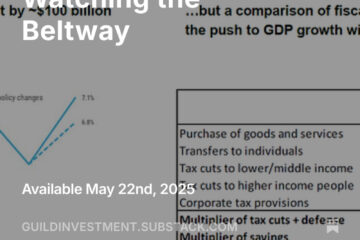The Markets In 2017: Inflation, Stocks, Bonds, and Gold
Despite headlines declaring that the post-election rally is running out of steam as we head towards Inauguration Day, we continue to be optimistic about the prospects for the U.S. stock market for over the next several months. Later in the year there is more potential for corrections from a few sources, which we will note below.
Watch Inflation and Treasuries — Don’t Just Count the Rate Rises
We believe that U.S. headline inflation will reach 3% in the first half of 2017. As the Economist observed this week:
“Headline inflation in the rich world is likely to rise quickly in early 2017, thanks largely to rising oil prices and a generally firmer global backdrop. Underlying inflation will grind up more slowly as above-trend growth eats away at available slack. A burst of stronger headline inflation this year might drive up inflation expectations… [Some analysts] expect higher inflation to add one percentage point to global nominal GDP in 2017, spurring a revival in profits…”
Many observers are worried about the effect of rising U.S. rates on stocks, given that the U.S. stock market as a whole is not cheap. We believe that as long as the yields on U.S. 10- and 30-year bonds are at or below the U.S. inflation rate, growth stocks will be able to move higher — particularly the stocks of companies with earnings that are growing strongly. At this writing, 10-year U.S. Treasury bonds are yielding 2.34%, and 30-year are yielding 2.95%.
Data Source: Federal Reserve Bank of St Louis, Bloomberg
Rates will rise, but we believe inflation will rise faster (and it has been, as you can see in the chart above), and when it does, it could derail the Fed’s leisurely pace of rate increases. When the inflation rate reaches 3% and forces up the 10-year Treasury yield, stocks are much more likely to be subject to correction. We think this comparison — Treasury yields vs. inflation — will be more significant than the old “three steps and stumble” rule of thumb. (That rule suggests that markets correct after the Fed hikes for the third time; what’s more significant under current conditions is an inflation spike that forces rates higher.)
Until that happens, as we said above, we like the stocks of companies that can grow their earnings. We note that this may not mean the stocks of companies that are considered “growth stocks.” With the new administration moving towards tax and regulatory relief, for example, banks may find themselves suddenly able to grow their revenues and earnings at a pace that warrants calling them “new growth stocks.”
Where Volatility Could Come From Later in 2017 — and What It Means For Gold
Besides the relation of inflation and Treasury yields, there are a few other potential sources of disruption in 2017.
First, there is the ongoing strategy of the incoming administration to use the Presidential “bully pulpit” to influence, shame, and cajole anyone with whom Mr. Trump is negotiating (and that means pretty much anyone he’s dealing with at all). The media will magnify the conflicts. Industries and companies that find themselves on the receiving end of Mr. Trump’s negotiating strategies will experience disruption.
The U.K. will continue down the road to Brexit. Prime Minister Teresa May laid out her Brexit vision on Tuesday, and made it clear that the U.K. will be really out — no attempts to finesse a half-in, half-out compromise. Besides impending Brexit, Europe has other worries ahead. Italian banks remain weak, and may eventually cause instability in the European banking system. Dutch and French elections are approaching in the first half of the year; both have the potential to give victories to populist and Eurosceptic parties.
The prospect of inflation; the prospect of pushbacks, conflicts, and roadblocks in the implementation of policies by the new U.S. administration; the prospect of media consternation about Mr. Trump’s brash negotiating strategies; and the prospect of political and financial worries in Europe — all this leads us to be bullish on gold and gold shares over the next several months.
Investment implications: We continue to be optimistic about U.S. stocks for the next several months. We’re watching inflation closely. We believe inflation could reach 3% in the first half of 2017. If rapidly rising inflation derails the modest path of interest-rate rises contemplated by the Fed and pushes bond yields up more quickly, that could make the stock market more vulnerable to correction, and we would get more bearish. Until then, we like stocks that can grow earnings fast — which might include some stocks in unexpected sectors and industries, such as banks and financials. We like gold for the next several months. It could benefit from rising inflation, potential volatility as the new administration starts its political battles in earnest, ongoing Brexit worries, more potential electoral victories for populists in Europe, and continuing troubles in Italy’s banks.




